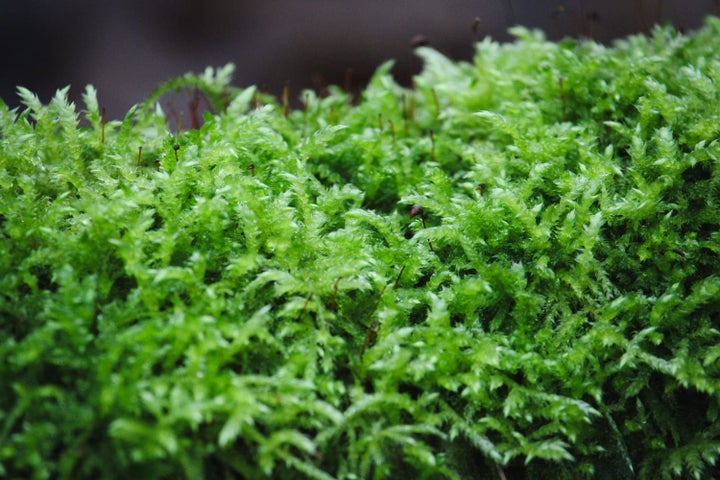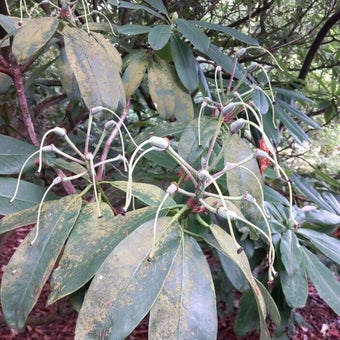
Quick facts
The sides of tree trunks facing the prevailing wind and rain are often colonised by moisture-loving mosses and lichens
Although small, they are an important part of garden ecosystems, and there is no need to get rid of them
Algae and mosses require a moist environment to reproduce
The UK contains a rich and diverse range of native algae, lichens and mosses
Algae, lichens and mosses are sometimes mistaken for fungal diseases
What are algae, lichens and mosses?
Algae
Algae are simple, plant-like organisms. They can photosynthesise (harness the energy in sunlight) but don’t have true roots, stems or leaves.
Branches and trunks host algae that appear as green, orange or rusty-red fine deposits; these are most likely to be seen on the northern side of a tree. Trentepohlia is a common type of algae on trees in the UK; the species T. umbrina is easily noticed, due to its conspicuous rusty-red colour.

Some types of algae also grow on evergreen leaves; see our guide to Algae on leaves for more information.
If you are interested in studying algae, the British Phycological Society website is a useful source of information.
Lichens
A lichen is not a single organism; it is a symbiotic (mutually beneficial) association between a fungus and an alga, or a fungus and a cyanobacterium.
Some lichens grow well on the trunks, stems and branches of trees and shrubs. They may form crusty patches, leafy mats, or upright branching or hanging growths on the . Many are green or grey in colour, such as the grey-green tufted growth of Ramalina farinacea (shaggy strap lichen). However, some display yellow and orange colouring, such as the commonly seen Xanthoria parietina, although it is often grey when growing in shade.

If you are interested in lichens, the British Lichen Society website contains lots of helpful information, including descriptions and images to help with identification.
Mosses
Mosses are small, low growing plants that reproduce by spores. There are over 700 species of mosses in the UK, ranging from dense mats of flat growth, to loose tufts or rounded cushions. They have stems and leaves, but instead of roots they have shallow rhizoids (small hairlike structures) that anchor them to surfaces.
Some mosses that are common on trunks and branches include – Hypnum cupressiforme (cypress-leaved plait-moss), Lewinskya affinis (wood bristle-moss) and Brachythecium rutabulum (rough-stalked feather-moss).

The British Bryological Society website contains lots of useful information on identifying, studying and conserving mosses.
See our page on Algae, lichens, liverworts and mosses for information on where else in your garden you might find these interesting organisms.
Liverworts can also grow on trees. Metzgeria furcata (forked veilwort), for example, favours ash, sycamore and willow trees; its yellowish-green growth attaches closely to bark and forks at the tips. Frullania dilatata (dilated scalewort) is another liverwort sometimes seen on trees; it is green or brown with rounded lobes. Especially tolerant of drying out, it can be seen in well-lit positions, such as high up on the trunks of trees, even in drier parts of the UK.
Do I need to get rid of algae, lichens and mosses on trees and shrubs?
There is no need to remove algae, lichens and mosses from woody plants as they are not parasitic and do not cause any harm – they are just using the trunks and branches as a surface to grow on.
They can, in fact, be beneficial and allowing them to grow:
- Boosts the of your garden – a woody plant can support many species of algae, lichens and mosses. Some species are rare, and many are threatened by habitat loss, climate change and pollution, so you can help conserve native species simply by allowing them to grow.
- Provides food and habitats for garden wildlife – they offer shelter to small creatures, including beetles, spiders, springtails and woodlice. Mosses are used by garden birds as nesting material and are a food source for many moths.
- Adds character – algae, lichens, and mosses add another level of interest to trees and shrubs, creating a sense of maturity and permanence. Growths can form tapestries of colour and texture on and wood, providing winter interest after leaves have fallen.

However, if woody plants are grown for their attractive bark or stem colour, gardeners might want to get rid of any growths that obscure these features.
Algae, lichens and mosses tend to be more common on plants lacking vigour, so their presence could indicate a need to improve the overall health of a plant. Algae and mosses, for example, tend to favour the damp, shady conditions created by congested growth on neglected trees and shrubs, while many lichens favour the bright conditions of a sparse canopy. If algae, lichens and mosses are seen on sickly or neglected plants, it is important to remember that their presence is a result of the plant’s condition, rather than the cause of it.
Lichens and algae are sometimes mistaken for fungal growths; if you are an RHS member you can use the Gardening Advice service to identify growths you are unsure about.

Did you know?
There are at least 13,000 species of lichens, of which 2000 grow in the UK. The number and diversity of lichens is reflected in their many uses, which include – as a food, as poison, as a raw material to make and dye fabric, as an ingredient in perfume and as medicine to treat minor ailments and serious diseases.
How do I manage algae, lichens and mosses on trees and shrubs?
If you have algae, lichens and mosses growing where they are not wanted, they can be discouraged and controlled in two ways:
- Adjust the growing conditions – growths of algae, some mosses and a small proportion of lichen species will be discouraged by pruning out overcrowded branches and removing overhanging vegetation. This will improve air circulation and reduce shading.
- Encourage the tree or shrub to produce new growth – vigorous growth is less likely to host algae, lichens and mosses. Try to stimulate new growth by mulching, watering during prolonged dry spells, and feeding if your soil is poor or there are signs of a nutrient deficiency. Once your plant regains vigour, the most affected twigs and branches can be pruned out. However, lichens and mosses can grow well on vigorous new growth in areas with high rainfall and , particularly in western parts of the UK.
Gardeners who don’t want algae, lichens or mosses on woody plants might be tempted to physically remove them. Brushing or jet washing the growths off risks damaging the and branches, which could affect the overall health of the tree or shrub. And, as physical removal is just a temporary solution, algae, lichens and mosses will return if the growing conditions remain unchanged.










